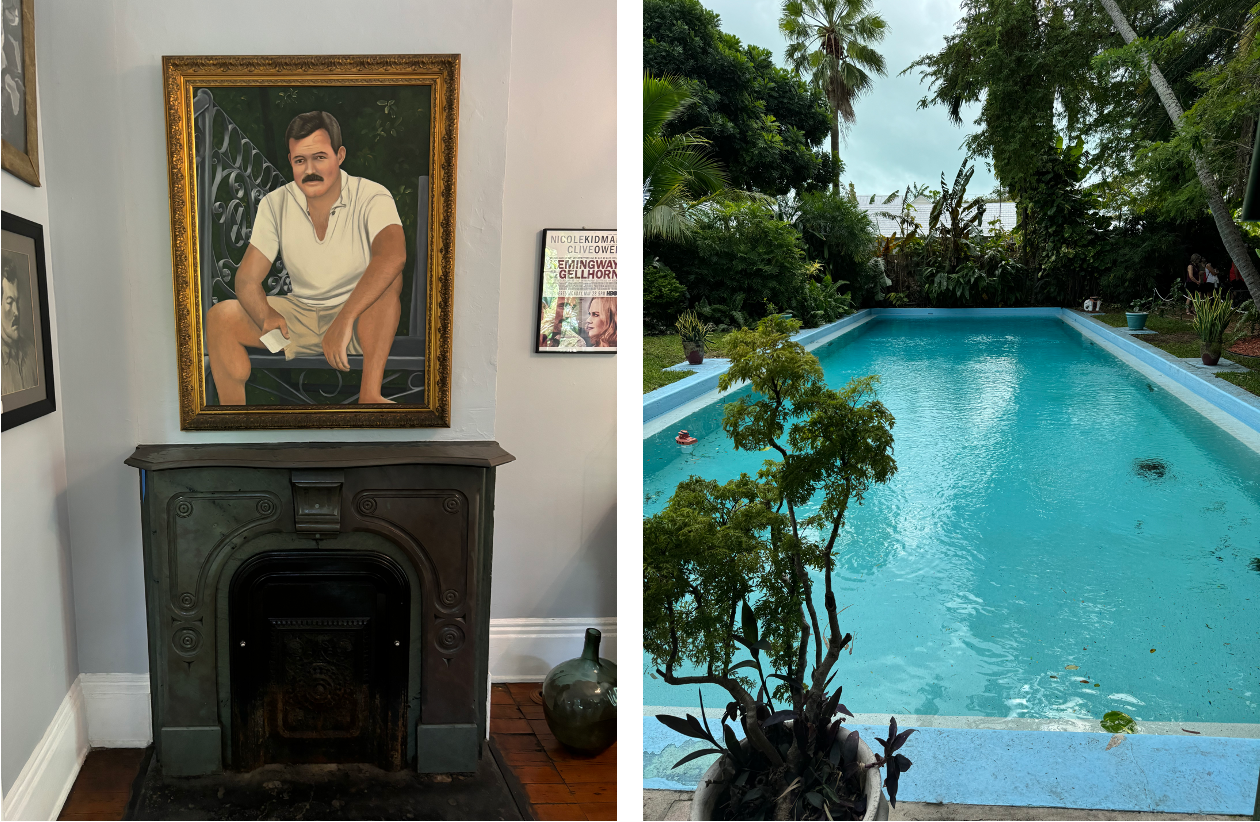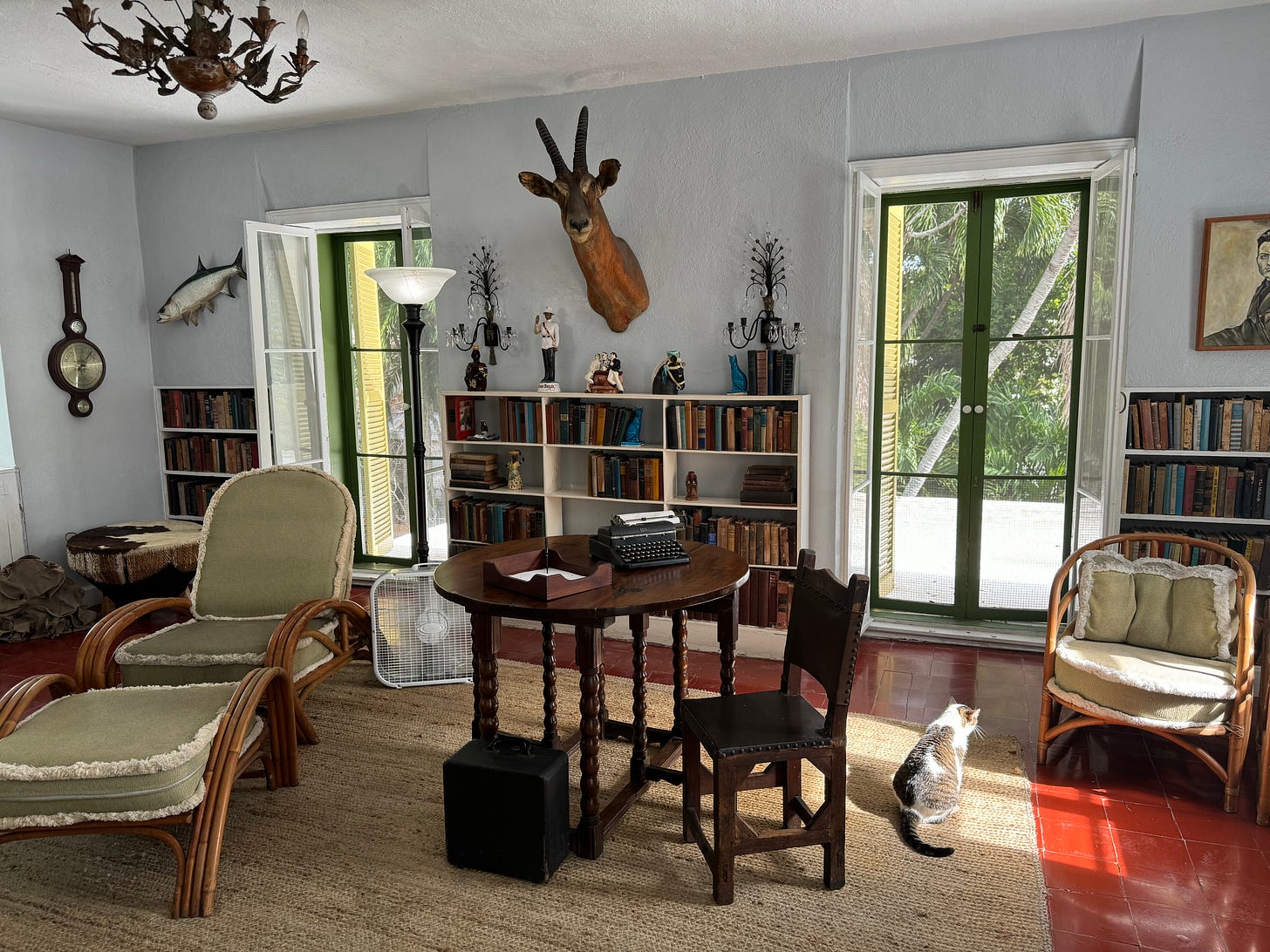Visiting Hemingway's home in Key West
Writing life: 50

I know what you’re thinking: “Haven’t I written enough about Hemingway already?” You may be right, but when you’re a writer vacationing in Key West, you visit Hemingway’s home. You just do.
But it is true, I have written about my love-hate relationship with Ernest Hemingway before, particularly in a past post entitled Trying to understand my Hemingway Fixation, but also in an even earlier post about having lunch with his Oscar-nominated granddaughter, Mariel Hemingway. But late last month, Nancy and I escaped Toronto’s cold snap and spent a week in warmer climes, including a few days in the southernmost community in the continental United States.
The Florida Keys
That’s right, after three nights in Miami Beach, we drove south through the Florida Keys all the way to Key West. It was a first visit for us both. I have always wanted to make the drive from Miami Beach along Highway 1 and then out over the water, where the Atlantic Ocean meets the Gulf of Mexico.
It was a fun drive along causeways, bridges, and thin strips of land. Highway 1 is aptly-named the Overseas Highway. While it is a very touristy route with lots of attractions along the way including the Theater of the Sea—we did not stop there—but the scenery along the way was quite spectacular as you literally drive overtop of the ocean for long stretches. Of course, Key West is the southernmost key. From there, Cuba is just a 90-mile voyage over the waves.
Key West
As you might expect, Key West is also very touristy with dozens and dozens of restaurants, bars, T-shirt and bikini stores, hotels, resorts, music venues, and museums crammed onto an island of only 4.2 square miles. Downtown, the main drag, Duval Street, is a bit—or a lot—garish, gaudy and kitschy, but we had a blast and got to know Key West pretty well over our short visit.

Hemingway’s home
Hemingway moved to Key West from Paris in 1928 with his second wife, Pauline Pfeiffer. Initially, they lived in an apartment as they explored island living. But when they fell in love with Key West, Pauline’s generous Uncle Gus bought a house at 907 Whitehead Street for them as a gift at the cost of $8,000. (Wouldn’t we all love to have a wealthy Uncle Gus?) In 1931, Pauline and Hemingway took ownership and renovated the home. It still looks today very much as it did back then.
The home sits on a large plot of land, dwarfing the neighbouring properties as you can see in the schematic below.


Just behind the house is a separate building where, on the second floor, Hemingway set up his writing studio. Every morning, sometimes starting as early as 5:00 a.m., he’d head to the studio and write. His writing was about the only thing about which he was so disciplined—although many would add drinking and womanizing to the list.

In the afternoons, he’d either go fishing or drinking—and often, both.

Sloppy Joe’s was Hemingway’s favourite dive bar in Key West. It still operates today. It’s also where, in 1936, the 39 year-old Hemingway met a 28 year-old journalist named Martha Gellhorn. They would marry in 1940, just seventeen days after his divorce from Pauline Pfeiffer came through.
Wrapping up…
Visiting Hemingway’s Key West home felt a little like a pilgrimage of sorts, given how much reading I’ve done over the years about him, his writing, and his life. Despite my misgivings about Hemingway as a writer (I just don’t like his spare and sparse prose), not to mention his often deplorable behaviour, there is no doubt he was instrumental in reshaping the literary landscape in the 1920s and 30s. A Nobel and Pulitzer prize winner who packed a lot into his nearly 62 years, he remains, arguably, the most famous writer of the twentieth century. I contend that other great literary figures of that era, like F. Scott Fitzgerald, William Faulkner, and Thomas Wolfe, were famous for their books. But Hemingway’s fame somehow transcended his own works, and he came to represent for many—even those who never read his books—the quintessential writer.
For me, reading about his time in Paris in the 1920s kindled an abiding interest in the City of Light and the expat writers who flocked there after the First World War. I guess you don’t have to like the guy, or even his writing, to be interested in his life and impact on literature. Hence my visit to the home he shared with Pauline Pfeiffer and their sons in the Key West of the 1930s.
Coming up…
Our short trip south was a lovely little break and I’ve returned, re-inspired and re-invigorated. It’s time to bear down on my next novel, number ten. The story is pretty-well nailed down now, so it’s on to developing my scene-by-scene bullet point outline that will likely end up running upwards of 90 pages. I hope to have that outline finished by the end of March, and then be writing the manuscript sometime in April. The plan is to finish the manuscript and turn it in to my editor by the end of August. (More on the new novel in future posts.)
Let me leave you with a shot I took of a vivid Key West sunset.
Thanks for checking this out. I’m hoping you’ll consider subscribing. It’s free and easy, and you won’t miss any future adventures. See you in two weeks for another instalment.








Another “to visit” spot added to our list, thanks for the introduction. And a 90 page bullet point outline? I love learning how writers develop their novels. Looking forward to reading #10.
A lovely travelogue piece melding the Keys with Hemingway. My wife and I took the tour in 2014 April (our last trip, as it turned out, before she was diagnosed with cancer). Like you, I don’t much care for Hemingway’s writing but his dramatic depressing life captures the attention of we authors romanticizing the notion of the artist as a tragedy. Like you, I explored Hemingway’s Paris – lounged on the sidewalk tables of Les Deux Magots one balmy afternoon. And speaking of barmy, I do hope you noticed the Key West chickens in your three-days walk-about.